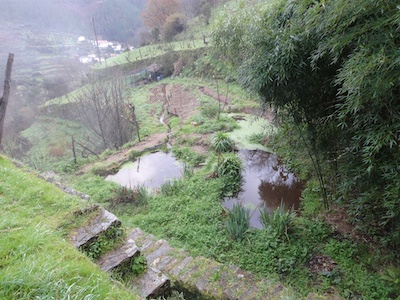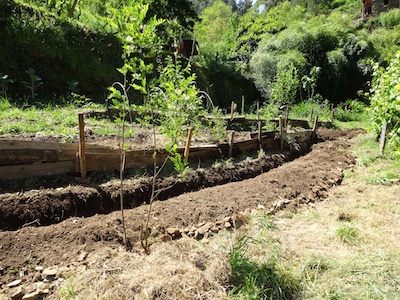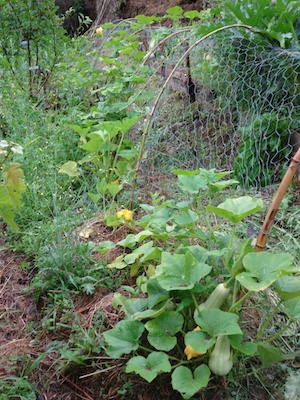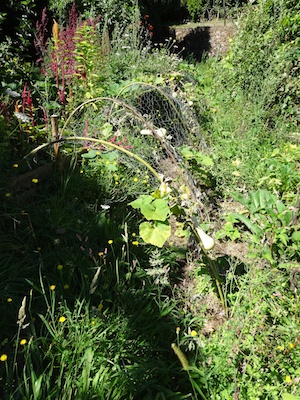Swales – level ditches dug to follow the contours of the land – are one of the principal ingredients of permaculture earthworks which are, by and large, recipes for catching and holding rainwater runoff and encouraging it to slowly infiltrate the soil rather than being lost to the nearest river. Because they’re level, swales don’t channel the water away but hold it in situ until it soaks into the soil. They can be dug to any sort of scale and used alone or, as part of an integrated water catchment system over an entire property, in combination with other elements like ponds, infiltration basins and dams.

On narrow terraces and steep mountain slopes with thin soils – ie. here – swales are not something you can use on a large scale, but they can still be useful. When I dug the lower ponds, the effect on the ability of the surrounding soil to support abundant growth was immediate and impressive, but it didn’t extend too far along the terrace. Just 2 metres away the soil was so dry in summer it barely supported a few grasses and wildflowers and would turn to dust in your hand and blow away. So after working out the contours of the terrace, I decided to extend the area of hydration much further along by using the ponds to feed small swales.
Since the slope of the terrace dictated that the two ponds are on two different levels, I would be able to run two main feed swales out across the terrace, one from each pond. The contour lines run diagonally across the terrace, so by using constructed spillways, I could create more swales below the lower pond level, potentially taking the water right along the terrace as far as an outcrop of bedrock where the terrace turns a corner and changes orientation.


Main feed swales leading from the ponds
To begin with, the presence of a temporary winter bed of cabbages and onions at the back of the terrace prevented me taking the swales the full width of the terrace, but they’ve now been dug right the way across.
I started work back in January after doing some remedial work on the ponds. The unlined ponds have been stable for a good couple of years now but a persistent problem has been burrowing rodents breaching the ponds and draining them out though their runs (usually through a terrace wall, so not to be encouraged). I used some of the slightly mangled corrugated metal sheeting we’d used as formwork for the water tanks cut down into lengths of roughly 3/4 metre and sunk vertically around the most vulnerable bits of the banks to create a physical barrier before backfilling with soil. Not pretty, but pretty effective. There’s only been one breach since, and it opened into one of the swales.

Lower main feed swale. The bottom of the swale is flattened and level
Rather than landscape the terrace into the classic swale and berm – the berm being formed on the downhill side of the swale by the soil dug to make the swale – I created mini terraces, retained on the downhill side by posts and sawmill offcuts and levelled the soil out in between to create growing beds. The area had already been planted with several apple trees the preceding year, so the trees were interplanted with shrubs such as redcurrant, goji berry and Buddleia, and comfrey as mulch and soil improver.

Lower main feed swale again, showing the mini terrace above it (hydrated by the upper main feed swale) and the A-frame used to find the levels
In May I extended the system by adding a third swale downhill of the second and also fed from the bottom pond. This time I had some help. With this swale, we used the classic berm along most of its length, largely because it’s too close to the terrace edge to do otherwise.

Downhill of the third swale showing the berm and a primary coloniser – Black Locust (Robinia pseudoacacia) – planted for shade, mulch and nitrogen fixing
The swales were filled with prunings and mulch to cut down evaporative losses and we constructed mini chinampa-style trellises with bamboo and chicken wire to support the squashes we then planted on the downhill banks of the swales. A handful of compost was added to each squash planting and a lot of mulch but no other work was done to the soil. I wanted to see what it was capable of producing at this stage with just the benefit of the swales. The remainder of the beds were planted with self-seeding annuals such as amaranths and red orach, Welsh bunching onions, cabbages and courgettes.

Swales and beds mulched and newly planted

June and plantings are starting to take off

Butternut squashes on the mini trellises

August and the previously dry barren terrace is a jungle
The squash harvest was reasonable for essentially unfertilised ground.
I’ve been encouraged enough by progress so far to start on extending the system further. At the end of July, I lost all the chickens to local free-ranging dogs who managed to unlatch the fastening on the gate to the compound (at shoulder height) and then break open the gate. The compound has now been dismantled and I’m enlarging it to take in a wider area with a downhill boundary which extends all the way to the previously mentioned outcrop of bedrock. The lower main feed swale will fill a small duck pond, which will then drain into a further swale running the length of the perimeter fence. Outside the fence I’ll grow many more varieties of squash and other species which thrive on the nitrogen-rich run-off from the poultry pen while also providing summer shading for the birds.
Increasing the water holding capacity of the soil in any location is about more than just getting water to it though. Improvements need to be made to the soil structure, massively increasing the organic content and the depth of the topsoil, encouraging the presence and build-up of soil organisms, and planting soil building vegetation amongst the food plants.
I don’t necessarily see the ponds feeding the swales on a permanent basis. Once the soil becomes capable of holding considerably more moisture than it can at present – to the point where it’s able to sustain a reasonable level of moisture throughout Portugal’s hot summers – then the connection to the ponds becomes superfluous, at which point the supply for the duck pond may well be piped instead. The swales themselves will be maintained to continue to collect and infiltrate surface run-off through the winters.

Nadine Zdanovich November 12, 2014
This is really great, Wendy! I am really sorry to hear about the demise of the chickens. I always look forward to your posts. :-)
Quinta do Vale November 12, 2014
Thanks. My chickens aren’t the first to be taken, unfortunately. The owners won’t even countenance the possibility their dogs are capable of it, let alone responsible for it, despite several sightings of them taking other people’s birds and the fact that no other dogs in the area can open a fastened gate. Aside from being allowed to run ‘free’ (ie. all over other peoples’ property, making a continual nuisance of themselves), the dogs are ‘vegetarian’, so of course they’re going to supplement their diet when they can, particularly when they’ve been given no boundaries! I’d love to give my birds a bit more freedom but it’s impossible with these dogs on the loose. So the next pen is going to have some dog-proof fastenings …
Andy Swales December 13, 2014
Very intersting to an organic grower in Scotland thinking of moving to somewhere (not decided yet) on the Iberian peninsular.
Quinta do Vale December 14, 2014
Yes – the biggest change is going from an environment where there’s too much water to one where there’s too little. The first winter I spent here it rained more or less constantly from November to March and everyone I knew was going around with long faces. People kept asking me how the hell I could be so cheerful with so much rain, but it was easy! I knew the rain would eventually stop! Unlike Scotland (which was where I came from) …
Northern and Central Portugal does get a lot of rain (Atlantic coastline), but it all falls in the autumn/winter/spring. It can be dry from mid May until late September and hot summers can go up to 45°C. Good water conservation and management is essential. If you’re thinking of making the move, then put year-round water number one on your list … and two … and three … and preferably surface water. Subsurface reserves are being drawn down at a disturbing rate all over the peninsula (Spain is worse I believe) and around here the continuing growth of eucalyptus plantations isn’t going to be improving that situation any time soon.
Frank Antonson December 25, 2014
Wendy, I find your work and especially your writing to be superb. I understand soooo well what you are doing with swales. I have been doing that by hand on my “farm” for about 30 years. This land is mountain land that was mined for iron ore, so the soil is terrible. Still, the principal of contour ditching as a step toward fertility, or at least diversity, is as sound as ever. (There is also the added advantage in my case of the ditches, in their neutrality of agenda) revealing forgotten archeaological features.) This year in my “Frank’s School” I intend to devote considerable time to the subject of water. Portugal (Brazil and Peru) in many ways has been my model. In fact, during the second two weeks of May I will be driving around the mountains in your area to see the terraces. I will continue to read your articles, and I would love to know more about you, yourself, and how you ended up where you are
Quinta do Vale December 26, 2014
Hi Frank. There’s answers to some of your questions on this site. See How we got here.
Frank Antonson December 27, 2014
Thanks. I’ll read that (again, I think). There is so much to read on your site! I personally have been slow to warm up to the term “permaculture” ever since I first encountered it in the 1970’s, — not to the impulse, but to the term. I have to get past that. In the 60’s I found so much about what I saw as incomplete and often inconsistent — the dreams of starry-eyed hippies. I wanted something — and still do — that can really last. Because of that I studied the polyculture of Minho two years ago — a lesson for the world, I think. Well, once again, I commend what you are doing and I love to read what you write. I hope you can keep your enthusiasm. I, myself, often get discouraged as I go about building a handworker’s village. In the USA there are so few people that can lift their eyes above the comsumer’s culture all around them. Thanks for getting back to me.
Quinta do Vale December 27, 2014
I know what you mean. There’s many times I’ve contemplated removing the p-word from this site, but the bottom line for me is that permaculture design science is sound and it’s what I’m using. So the fact that there’s a lot of people out there jumping on the buzzword bandwagon without really understanding it or practicing it outside of their heads doesn’t mean the fundamentals are wrong. It’s just like all the religions really – and I include the religion of ‘science’ in that too – the underlying basic tenets are solid. It’s just in the interpretation and practice it all gets a bit skewed.
I haven’t spent much time in the Minho, but if the polyculture practiced there is anything like what they do here (or did before the agrochemical salesmen and the eucalyptus mafia got here) then I know what you’re talking about. Add mulch to the recipe and yes, I think it’s a great model.
It IS easy to get discouraged when you look around you at all the mindless damage and destruction going on. For that reason I try not to do that too much and just keep focused on what I’m doing here. I do sometimes wonder how much difference it’s possible to make on just 2 hectares, especially when I see so much deforestation and eucalyptus planting going on around me and threatening the already fragile water supplies here, but I also have a lot of trust in the lifeforce of the planet. As cells in its body, we really have no option but to respond to its needs and witnessing so many people suddenly discovering a burning desire to go take care of a patch of land somewhere is a wonderful thing indeed. Keep on keeping on!
Frank Antonson December 27, 2014
Yes. I will keep on keeping on. And what you say about 2 hectares and what can be accomplished…Well I often say to my best friend, Shirley, a German woman who understands me and wants to help, I want to change the world. It is as simple as that. It doesn’t mean that I will pull it off, but that is honestly what I want to do. I have an orientation toward “handwork” (Artesanato, em Portugues) but not simply to make pretty things for tourists — oh no! Maybe we are different that way. An organic gardener is, to me, a handworker — probably the most important one, but there are many others. for example the blacksmith. This is quite a long story for me, or from me, but much of it was learned in Brazil and then later fortified in Portugal. Ah! There is so much to say, and I still want to read a lot of what you have written. Water is, to me, almost a “god”. If you are interested, you might want to watch some of what I put on my channel. At the moment I am posting a “Prospectus”. That way, if I am not able to do what I want to, I can at least show what I was trying to do. Thanks for your comments!
Frank Antonson December 28, 2014
Minho is a little different, I think, from where you are and from the agriculture that was once practiced where you are. In much of Minho the ground is VERY fertile. The part that I know best is closer to the sea than the mountains. There terraces are still beautifully used, but they are not quite as critical. I first saw Minho from the train going south from Santiago de Campostela. It was dawn, and I was astounded by what I saw. I tried to capture it on film and it is available for viewing on my Youtube Channel, but that was not very successful. There was once a law passed there outlawing vineyards of the kind upstream from Porto. Grapes were only allowed around the perimeters of the Quintais. That way the full sunlight in the center was saved for the growing of grain — a matter of national security at the time. A year later, this time with my friend Shirley, I returned to get a better look — also available on my channel. The most interesting thing there is probably the Quinta Pedagogica at Braga. I’ve never really seen anything like it before or since.
Quinta do Vale December 28, 2014
The soil here is also fertile, being as the bedrock is schist rather than the granite that features in most of Central Portugal. Grapes are traditionally cultivated at terrace edges only and grain (rye mostly as far as I can make out) was grown here too though not to the same extent and you very rarely see it now. There are no traditional grain stores here like you see in the Minho and Galicia/Asturias. I will take a look at your videos after the New Year when my monthly data allowance gets refreshed.
Frank Antonson December 29, 2014
Yes. Your soil looks very fertile. I am anxious to revisit that part of Portugal. I drove through it only one day back in 1970! But I never forgot it. I should probably give you some links because there are SOOO many of my videos online. On the way back from Galicia Shirley and I saw incredible landscape along the top of the mountain range bordering Spain. There, amid the Granite boulders, I could imagine topsoil being sold by the bucket!
tony uljee September 25, 2015
im a fairly recent convert to permaculture , and as soon as my man shed/house building project is complete will devote more time into our 2 acres for a more self resistant way of life. Only recently discoved Paul Stamets and his ideas on fungi and how it works on /in our soils , and im trying a few homebrewed ideas or techniques on making the “black soils” to create my own preta , interesting to read how your soil fertility is and has progressd